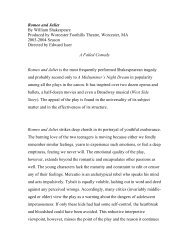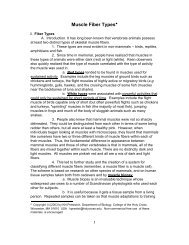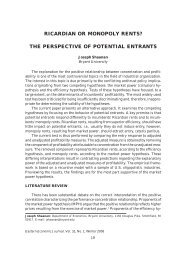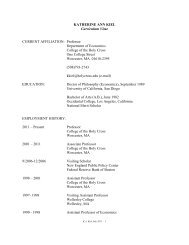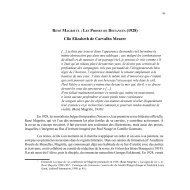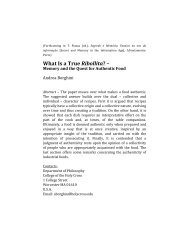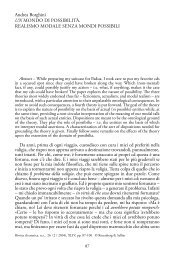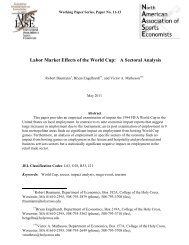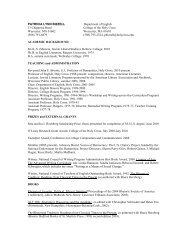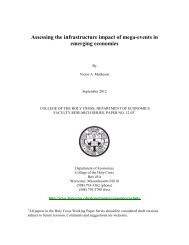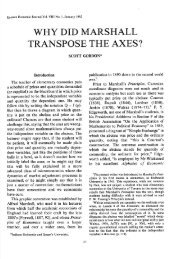29-2 Singh.pmd - College of the Holy Cross
29-2 Singh.pmd - College of the Holy Cross
29-2 Singh.pmd - College of the Holy Cross
You also want an ePaper? Increase the reach of your titles
YUMPU automatically turns print PDFs into web optimized ePapers that Google loves.
CAPITAL ACCOUNT LIBERALIZATION<br />
199<br />
The recent Asian crisis provides almost a laboratory experiment for examining<br />
<strong>the</strong> role <strong>of</strong> capital account liberalization in causing or exacerbating that region’s severe<br />
economic downturn. Williamson and Drabek [1998] provide evidence to suggest<br />
that countries that did or did not have economic crises were differentiated only by<br />
whe<strong>the</strong>r or not <strong>the</strong>y had liberalized <strong>the</strong>ir capital accounts. Most economists would<br />
now agree that even if premature financial liberalization without adequate prudential<br />
regulation was not <strong>the</strong> root cause <strong>of</strong> <strong>the</strong> crises in countries such as Thailand,<br />
Korea, and Indonesia, it greatly contributed to <strong>the</strong> occurrence and depth <strong>of</strong> <strong>the</strong> crises.<br />
Indeed, <strong>the</strong> economic fundamentals prior to <strong>the</strong> crises <strong>of</strong> <strong>the</strong> affected countries<br />
were better than those <strong>of</strong> India, but <strong>the</strong> latter country was spared <strong>the</strong> crisis because<br />
<strong>of</strong> its control over <strong>the</strong> capital account. Similarly, China managed to avoid a crisis and<br />
continued to have fast economic growth. China also had not liberalized its capital<br />
account. 9<br />
It is argued by some that even with <strong>the</strong> acute economic crisis <strong>of</strong> 1998-1999, over<br />
<strong>the</strong> long run Korea, with its economic openness, was a much more successful economy<br />
than India. This argument has some plausibility but overlooks <strong>the</strong> crucial fact that<br />
Korea’s outstanding industrialization record over <strong>the</strong> previous three decades was not<br />
accomplished by a liberalized financial system but ra<strong>the</strong>r by a highly controlled one.<br />
However, when <strong>the</strong> system was liberalized in <strong>the</strong> 1990s it was followed by an unprecedented<br />
crisis [Demetriades and Luintel, 2001].<br />
Social and Economic Costs <strong>of</strong> <strong>the</strong> Crisis<br />
The Asian crisis was extremely important in terms <strong>of</strong> its economic and social<br />
impact on <strong>the</strong> populations <strong>of</strong> <strong>the</strong> affected countries. The World Bank notes that “In<br />
terms <strong>of</strong> lost output and <strong>the</strong> implications for poverty and unemployment, <strong>the</strong> Asian<br />
crisis represents one <strong>of</strong> <strong>the</strong> most acute periods <strong>of</strong> financial instability in this century”<br />
[2001, 73]. The crisis greatly increased poverty, reduced employment and real wages,<br />
and caused enormous social distress. Indeed <strong>the</strong> economic downturn was so enormous<br />
that in a country like Indonesia <strong>the</strong> social fabric <strong>of</strong> <strong>the</strong> country virtually disintegrated.<br />
This is why <strong>the</strong> Asian crisis is aptly termed, not just an ordinary slowing <strong>of</strong><br />
GDP growth due to an economic shock or a normal cyclical recession, but an enormous<br />
meltdown. It is important to appreciate, however, that even if no meltdown<br />
occurs, economic slowdowns or recessions have bigger social costs in developing than<br />
developed countries because <strong>of</strong> <strong>the</strong>ir lack <strong>of</strong> publicly provided social security. There is<br />
evidence that in both country groups <strong>the</strong> effects <strong>of</strong> a downturn fall disproportionately<br />
on <strong>the</strong> poor and on women [<strong>Singh</strong> and Zammit, 2000; Stiglitz, 1999; World Bank,<br />
1998/99].<br />
Turning to an investigation <strong>of</strong> purely economic costs, <strong>the</strong>re are good analytical<br />
reasons to believe that economic crises would negatively affect both investment and<br />
long-term growth [Pindyck, 1991; World Bank [2001]; Easterly et al., 2000]. In addition,<br />
recessions and meltdowns also have fiscal and redistributive implications that<br />
may affect <strong>the</strong> economy for a long period <strong>of</strong> time. Caprio and Klingebiel [1996] estimates<br />
indicate that <strong>the</strong> costs <strong>of</strong> a banking crisis are typically quite large, ranging<br />
from 3.2 percent <strong>of</strong> GDP in <strong>the</strong> 1984-91 U.S. savings and loans crisis to 55.3 percent



